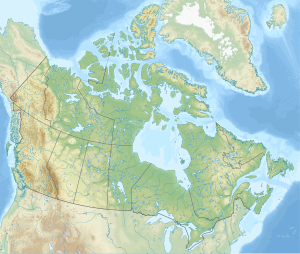The Redmond Formation is a geologic formation in Newfoundland and Labrador. It preserves fossils dating back to the mid-Cretaceous (Cenomanian). It was a thin (up to 1.5 metres (4.9 ft) thick) and restricted unit traced for 152 metres (499 ft) in a single mine (Redmond No. 1) in Labrador, overlying Paleoproterozoic rocks, with large amounts of rubble, probably as a result of graben subsidence within the Labrador trough. Argillite facies within the formation have produced a diverse flora and insect assemblage.[1]
| Redmond Formation | |
|---|---|
| Stratigraphic range: Early Cenomanian | |
 Geologic map and outcrops of Redmond Formation | |
| Type | Formation |
| Underlies | Glacial deposits |
| Overlies | Sokoman Formation |
| Thickness | Up to 1.5 m (4.9 ft) |
| Lithology | |
| Primary | Argillite |
| Location | |
| Coordinates | 54°42′N 66°48′W / 54.7°N 66.8°W |
| Approximate paleocoordinates | 46°24′N 27°18′W / 46.4°N 27.3°W |
| Region | Newfoundland and Labrador |
| Country | |
| Extent | Redmond Basin |
| Type section | |
| Named for | Redmond No. 1 mine |
Fossil content
editSusumaniidae
edit- Coleoptera indet.
Labradorocoleidae
edit- Cupedidae indet.
- Haliplidae indet.
- Peltodytes sp.
See also
editReferences
edit- ^ Demers Potvin & Larsson, 2019
- ^ Mueller, André S.; Demers-Potvin, Alexandre V. (2024-06-01). "New Late Cretaceous (Cenomanian) fossil mayfly nymphs (Oligoneuriidae, Heptageniidae, Hexagenitidae) from the Redmond Formation, Labrador, Canada". Canadian Journal of Earth Sciences. 61 (6): 712–722. Bibcode:2024CaJES..61..712M. doi:10.1139/cjes-2023-0133. ISSN 0008-4077.
- ^ Demers Potvin et al., 2020
Bibliography
edit- Demers Potvin, Alexandre; Szwedo, Jacek; Paragnani, Cassia; Larsson, Hans (2020), "First North American occurrence of hairy cicadas discovered in a Late Cretaceous Cenomanian exposure from Labrador, Canada" (PDF), Acta Palaeontologica Polonica, 65: 85–98, retrieved 2020-07-31
- Demers Potvin, Alexandre V.; Larsson, Hans C.E. (2019), "Palaeoclimatic reconstruction for a Cenomanian-aged angiosperm flora near Schefferville, Labrador", Palaeontology, 62 (6): 1027–1048, Bibcode:2019Palgy..62.1027D, doi:10.1111/pala.12444, ISSN 0031-0239
